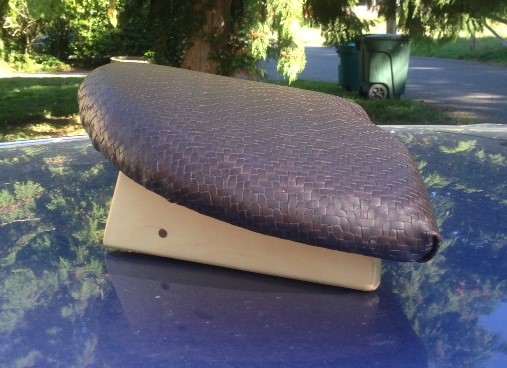

|
Siddhasana™ Meditation Seat News |
| |||
 |  |  |  |
|
|
|
Press Release:
Veatch's Cross Legged Sitting Device is now Patent Pending. Contact: Eric A Pattison / 206.384.2408 / ericpattison4495@gmail.com Monday, March 4, 2013. Seattle Washington USA -- For people raised on chairs, cross legged sitting can be painful if not impossible. An easeful, stable, erect, cross legged sitting posture provides a desireable foundation for sitting meditation and can improve subjective well-being and mental focus. A patent disclosure has just been filed, entitled "A Cross Legged Sitting Device" by Thomas C. Veatch, Ph.D., of Seattle. Dean Craine, P.S., of Bellevue, Washington, served as patent attorney. Veatch's device helps to raise hips above knees and to rotate the thighs top-outward in a cross-legged posture. It allows one to sit with less acute angles in the knees, and less rotation of the thighs, while still experiencing the benefits of cross-legged sitting. Feet can tuck under without being crushed under the body's weight. This helps sitters achieve a cross legged sitting posture with more ease and less pain, and can remain comfortably for longer periods. Dr. Veatch says, "Seats have always been designed for the user to sit on or in, therefore flat or concave when sat upon. This seat is designed for you to fall off not just the front but also the sides. The surprise is when your knee hits the ground or rests on the opposite foot, suddenly your feet, knees, and hips form a rigid triangle or truss structure. The foundation becomes solid and the tilt of the hips is also corrected. Cross legged sitting is great when you can get your knees down onto something. You have to see what happens." The slopes in the seat provide ergonomic support to the thighs which slope in the same direction: forward, downward, and outward. With knees below hips, the seat's forward slope encourages the hips to tilt top forward. This enables a cascade of beneficial posture changes including the forward shift of the small of the back and the lowest rib and the compensating rearward shift of the top of the ribcage. Due to these changes it becomes remarkably easy for the neck and head, instead of hanging diagonally in front of the chest, to balance vertically above the shoulders. Beneficial internal, subjective changes are often experienced by users. Nathan Satko, an early user, reports, "My focus is improved." One user has suggested, "We should call it the Blissinator." Veatch says, "You can instantly see the effect when someone straightens up and gets it. Compare pictures with and without and you'll be intrigued. Try it, and you'll be persuaded." Veatch and a manufacturer are presently in licensing negotiations to bring the seat to the market. For more information about the inventor, see tomveatch.com For more information about the attorney, see nwpatents.com
|